The calathea, a lovely houseplant with round or oval leaves, is a sight to behold. However, it needs special attention to maintain its health and vigor. Even a slight alteration in the conditions surrounding the calathea plants can have a significant impact, particularly on its leaves. For instance, curling of the leaves is a typical issue that affects calathea plants. In this article, let’s talk about the solutions for calathea leaves curling.
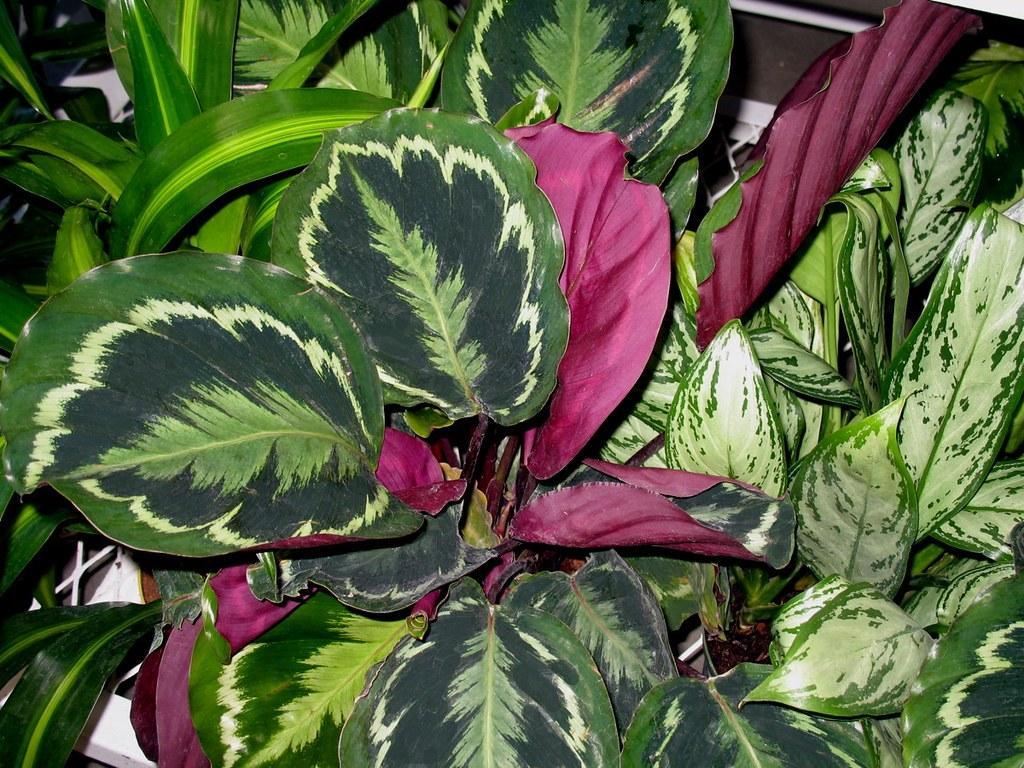
Calathea leaves curl when dehydrated to limit transpiration and prevent water loss.
In this condition, the vast, attractive leaves of calathea will, as the name suggests, curl and fold in on themselves. This could take place for a variety of reasons, including the following:
Calathea leaves curl primarily due to dehydration. Curling is a defense mechanism that slows the rate of transpiration, which is the process by which the plant releases water vapors through the stomata. Other causes of dehydration in calathea include underwatering, low humidity, warm weather, root damage caused by over-watering or over-fertilizing, disease, and the invasion of pests.
So, if you have calathea plants and their leaves are curling, read on!
We will help you figure out the causes and fix them in no time.
Causes Of Calathea Leaves Curling
The curling of calathea leaves can be caused by various underlying factors. The good news is that curled leaves do not necessarily signal a problem (yes, really).
This is especially true if the leaves only seem to move at night or after you have carried the plant home from the nursery. Nevertheless, here are the main reasons why the leaves on your calathea plants might start curling and how you can fix it:
Lack Of Water
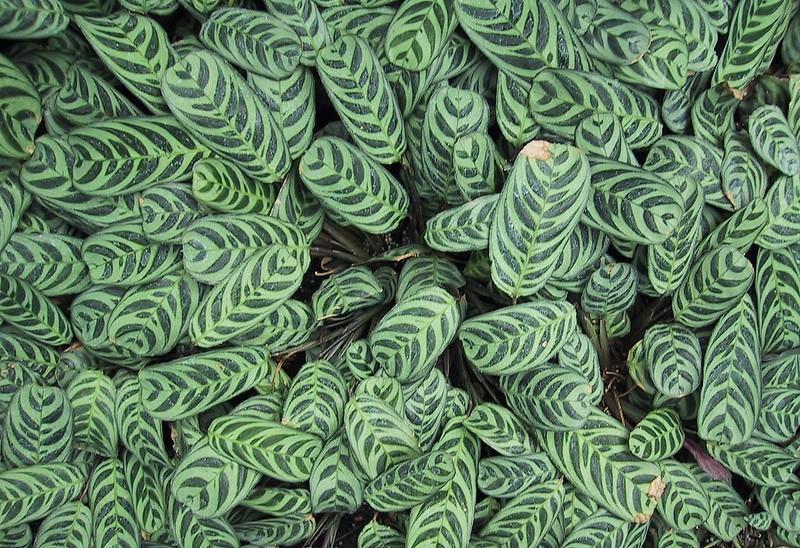
The most prevalent cause of calathea’s curled leaves is a lack of water.
Ask yourself, when exactly was the last time you gave the calathea a drink of water? If you are having trouble remembering, your plant is likely suffering from dehydration and thirst. And the most typical cause of calathea with curled leaves is a water deficiency.
Remember that plants, like all living things, have their own built-in defenses. So, when the calathea plant becomes dehydrated, the defensive system that it possesses will kick in and protect it from suffering any further dehydration.
As a result, Calathea’s leaves will curl inward to decrease the exposed surface area and, consequently, the transpiration rate.
Signs Of Dehydration
If the leaves on your calathea appear wilted and may have gone yellow or brown, this could be a sign that your calathea needs more water.
While the top two inches of soil may look good, a soil meter probe inserted halfway into the pot will give you an accurate reading of the soil’s moisture. If the number is greater than 3, the plant does not need any more water for the time being.
Fix
Use filtered or distilled water to water your calathea until water is dripping from the drainage hole in the bottom of the container. Calathea has to be watered at least once a week or whenever the top two inches of soil are dry, whichever comes first.
Furthermore, if you often forget to water your calatheas, you can also program your phone to send you a weekly reminder to water your plants.
Related: 20 Types of Calathea Plants that You Should Have in Your Garden
Excess Of Water

An excess of water can cause root rot; therefore, maintaining consistency in watering is vital.
Water is essential for plant growth, but it’s also necessary to know how much water to give them! Unfortunately, when watering our plants, most of the time, we over-water them since we do not realize how much water they require.
However, watering calathea or any other plant too much might cause root rot.
The illness known as root rot causes the roots of a plant to become waterlogged and damaged, rendering them unable to extract nutrients or water from the soil. This causes calathea to lose its moisture, which in turn causes the leaves to curl.
Signs Of Overwatering
If you find that the soil is still wet even after a week or two, this indicates an obstruction in the drainage, which is causing the water to remain in the pot. When calathea is overwatered, one of the very first symptoms that manifests itself is the appearance of brown patches on the tips of the leaves. Additionally, the dirt will have a foul smell.
Fix
You should be aware of the specific amount of water required for calathea each week to avoid overwatering the plant in the first place. Also, if the top two inches of the soil are already wet, your calathea does not need any additional watering.
If the soil remains soggy a week after being watered, inspect the drainage hole at the bottom of the container to see if it is clogged. Then, scrub each one of the openings to ensure that any surplus water may escape the container.
Low Humidity In The Air
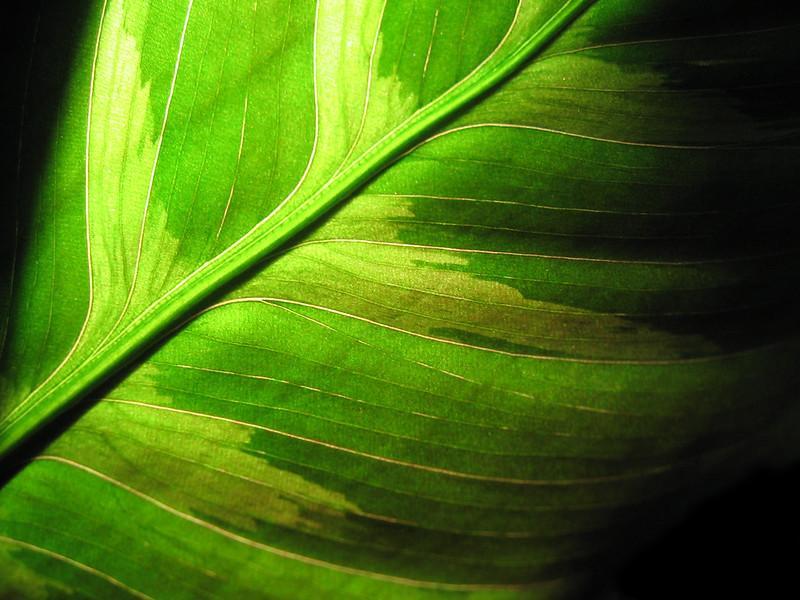
Low humidity around calathea plants causes leaf curling that resembles underwatering.
Calathea reacts to a decrease in the humidity in the air by raising the rate of transpiration, which results in a considerable loss of water and causes the leaves to curl. This happens when the humidity in the air falls below 50%. This occurs because of the principle of equilibrium, and water always moves from its highest to its lowest concentration.
Signs Of Low Humidity
The leaf curling induced by low humidity exhibits many of the same signs and symptoms as the leaf curling caused by underwatering. This is because calathea becomes dehydrated in both situations. Thus, the leaves will wither and become brown.
Utilizing a hygrometer is your best bet for determining whether or not the issue is due to low humidity or another problem entirely, such as dehydration. It is a piece of equipment that can determine the relative humidity of the air.
Fix
Calathea must be kept in an atmosphere with a humidity level of at least 60% in order for it to progress through the active growth stages. In most cases, a plant is employed as a humidifier in order to get the desired amount of increased humidity.
A plant humidifier is a piece of equipment that releases steam into the environment to raise the humidity level there. Therefore, in situations when the air is dry, you can keep it close to plants like calathea that require high humidity levels.
Excess Fertilizer
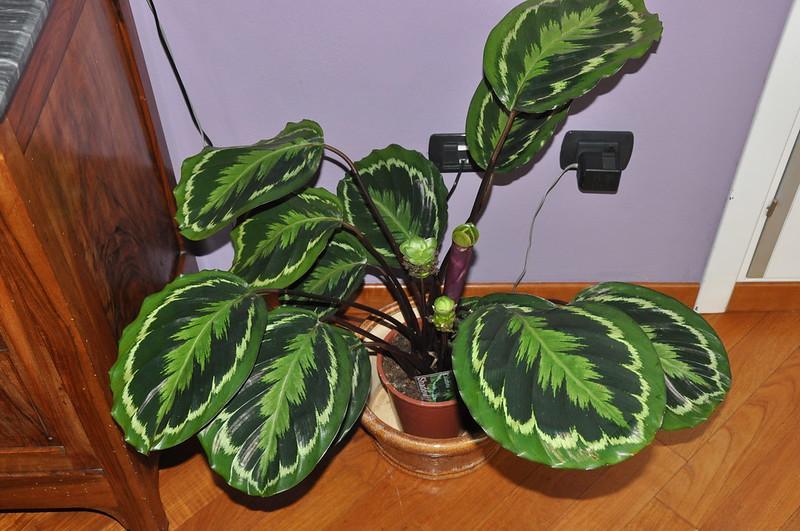
Fertilizers are hygroscopic and dehydrate soil and plant roots, causing them to curl.
You might believe that if you give your plants more fertilizer, it will help them grow more quickly, but unfortunately, this is not the case. Your plants could, however, suffer irreparable harm or even perish if they receive an excessive amount of fertilizer.
When an excessive amount of fertilizer is applied, the concentration of salts in the soil and in the area around the calathea roots rises. Salts are hygroscopic, which means they take moisture from the ground and the roots of the plant, ultimately dehydrating the plant.
As a result, the leaves of calathea will curl.
Signs Of Fertilizer-Overdose
In the event that you use too much fertilizer, you can observe a crusty coating on the soil or along the sides of the container. Additionally, the lower leaves of the calathea plant will become yellow and wilt as the disease progresses.
If your plant exhibits any of the symptoms described above, you should also inspect the roots of the plant, as over-fertilization of the plant can also cause damage to the roots.
Fix
When calathea receives excessive fertilizer, the roots of the plant suffer damage. To cure curled calathea leaves caused by over-fertilization, you first need to remove the plant from the pot and trim off any damaged roots.
After that, fresh soil should be added to the container, and the calathea should be repotted. In addition to that, ensure that you apply the fertilizer following the directions.
Related: Calathea Rufibarba: The #1 Care, Propagation, and Watering Guide For This Fuzzy Plant
Light & Heat Stress

Increasing temperatures have the same effect as dehydration on the leaves of calathea plants.
Another potential cause of your calathea’s leaves curling is direct sunlight, which can lead to the plant’s dryness and exacerbate dehydration. And, in order to keep the plant from drying up and dying from lack of water, the leaves will curl in on themselves.
Increasing temperatures have the same effect on the leaves of calathea plants. High temperatures accelerate the rate at which plants lose their moisture. Therefore, when the temperature rises, the leaves of calathea will curl in a similar manner.
Signs Of Heat And Light Stress
Sunburn on the leaves, which manifests visually as browning of the leaf margins and tips, can be caused by prolonged exposure to direct sunshine. The range of temperatures between 65 and 80 degrees Fahrenheit is ideal for calathea. Temperatures higher than 80 degrees Fahrenheit and leaves that are curled on calathea are indicators of heat stress.
Fix
If your calathea is placed in an area that receives direct sunlight, you should bring it inside during the warmer months of the year to maintain a more moderate temperature.
Then, keep the same routine throughout the winter, bringing it indoors to shield it from the severe cold. However, for the calathea to grow, you must ensure that it is situated close to a location that receives adequate amounts of indirect sunlight.
This will cause the transpiration rate to return to normal, and the leaves will straighten out.
Hard Water

Hard water contains calcium and fluoride, which stick to calathea roots and cause dehydration.
In most cases, the water that comes out of the tap is the most suitable for watering houseplants. However, there are occasions when the water sources that come from the city have hard water, which is harmful to the calathea plants. Mineral salts of fluoride and calcium carbonate can be found in hard water.
When the roots of the calathea plant absorb water that contains fluoride, fluoride builds up on the leaves of the plant and prevents photosynthesis from occurring.
In a similar fashion, calcium carbonate will build up close to the roots of the plant. This will cause the plant to get dehydrated, resulting in the leaves curling.
Signs Of Curled Leaves Because Of Hard Water
Toxic levels of fluoride can cause the leaves of the calathea plant to become brittle and twisted, with the tips changing from yellow to brown.
In contrast, calcium carbonate, which is left behind by hard water as it evaporates, produces a white chalky residue on the stem, leaves, and soil.
How To Fix Curled Calathea Leaves Due To Hard Water
The accumulation of salts in calathea plants and soil occurs when they are watered with hard water. Therefore, the best course of action is to repot the plant using new soil.
Also, when it comes to watering your calathea, you should never use hard water and instead stick to using distilled water, filtered water, or rainfall instead.
Related: How To Care for a Calathea Ornata? (Questions + Answers)
Spider Mite Infestation
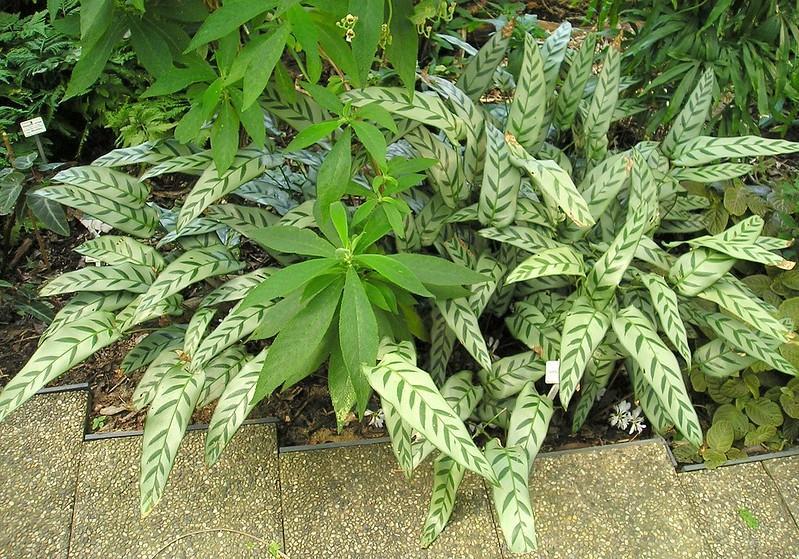
Insects, which feed on sap, lead to dryness, which in turn causes leaves to curl.
Due to the plant’s large, nutrient-rich leaves, calatheas are susceptible to attack from a variety of insects, including those that feed on the sap of other plants. Spider mites are one of the most prevalent types of pests that feed on the juice of the calathea plant. These insects, which feed on sap, lead to dryness, which in turn causes leaves to curl.
Signs Of Pest Infestation
Spider mites are difficult to detect because of their small size.
Spider mites, however, can be easily identified by their telltale symptoms, which include dry, wrinkled leaves of calathea as well as webs.
Fix
Neem oil is the most effective method for removing pests from calathea plants. It is natural and free from any harmful chemicals. Neem oil should be sprayed onto both sides of the calathea leaves. Apply it once a week until all spider mites have been eradicated.
Additionally, cleaning the leaves of the calathea plant regularly helps spot pests early on, making it much simpler to deal with them.
Soil Issues
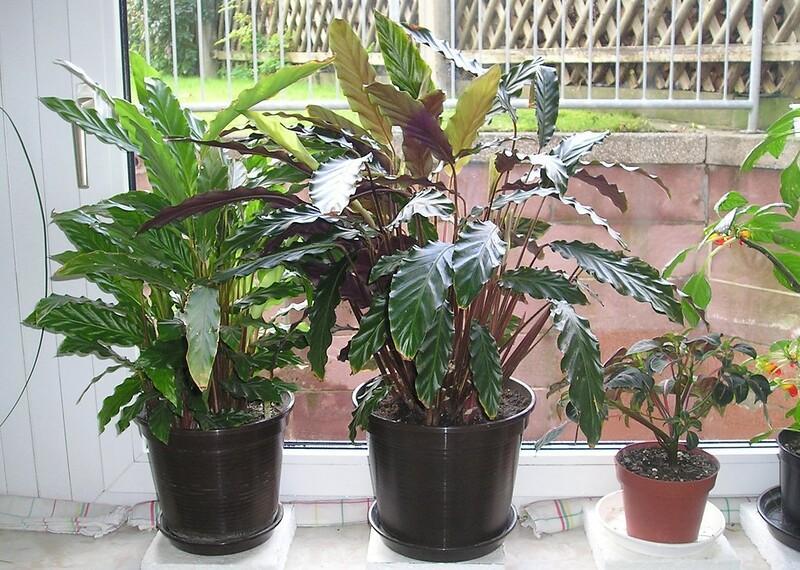
The quality of the soil contributes significantly to the overall health of a plant. Calathea absorbs soil water and nutrients. Thus, curling of the leaves of calathea can be caused by problems with the soil, whether those problems are related to moisture or nutrients.
Signs Of Soil Issues
Yellowing and curling of the leaves of the calathea plant are signs that the soil is deficient in nutrients and moisture. For example, if soil moisture does not diminish after being watered for several hours, it indicates a problem with drainage or the soil’s composition.
Fix
Feeding the soil with necessary nutrients is possible by applying the appropriate amount of fertilizer, which the plant can then take up and use. The leaves will straighten out and turn a vibrant green color as soon as the calathea plant receives the nourishment it needs.
However, if the problem is that the soil is holding on to an excessive amount of water, you may use a combination of coco coir or peat mixed with perlite or orchid bark to keep the soil moist and prevent it from holding on to an excessive amount of water.
Conclusion
When the leaves of calathea curl, it indicates that the air or soil is too dry. In order to thrive, calatheas need a lot of humidity and water. When the level of moisture and humidity in the air or soil is too low, the plant leaves may curl, and the edges may become brown.
However, there is no need to worry! Simply watering your plants and misting the air around them will solve the dehydration problem. However, in some instances, a lack of moisture could be caused by a disease, an insect, or a condition in the soil.
If this is the case, you will first need to address the underlying problem, and only then will you be able to solve the dehydration issue.
Frequently Asked Questions
Why are my Calathea leaves curled up?
Calathea leaves curl as a defense strategy to slow transpiration and prevent further water loss in dry conditions. This problem is frequently brought on by factors such as lack of humidity, hot temperatures, root rot brought on by over-fertilizing, and underwatering. Other contributing factors include disease and extreme temperatures.
How do you save a curling Calathea?
When the leaves of calathea turn inward, it indicates that the air is too dry. In order to thrive, different species of calathea need varying degrees of humidity. Installing a humidifier system around your plants is one of the solutions you can try to fix this problem.
How do you make Calathea leaves uncurl?
It is simple to get the calathea leaves to uncurl. You should hydrate it, but you should start at the bottom. Put the plant in a shallow dish of water and leave it there until it has absorbed all of the liquid. You won’t believe your eyes when you watch the leaves miraculously uncurl.
How often should you water a Calathea?
The calathea plant is sensitive to drought and must be watered regularly. In general, calatheas thrive with waterings once per week and with the top two feet of soil allowed to become slightly dry. Also, we advise watering less regularly during the winter months to avoid overwatering and the consequent root rot.
How often should I mist Calathea?
You should make it a habit to mist your Calathea on a regular basis (once a week is best), as this will guarantee that it gets the moisture it needs to thrive. Overwatering your Calathea is a typical mistake that can cause irreparable harm, but misting is a terrific way to engage with it and keep yourself busy without causing damage.
How do I make my Calathea happy?
Calathea prefers soil that is damp but not soggy to grow in. You might try combining equal parts charcoal, potting soil, orchid bark, and perlite in a ratio of 50:20:10.
Additionally, they do not want to be very dry. So, test to determine if the growing media is dry by sticking your finger into the soil every few days.
How do I bring my Calathea back to life?
Bringing a Calathea plant back from the brink of death is all about re-establishing the correct equilibrium. So, keep the soil moist but draining, place the calathea in strong indirect light, and maintain a temperature of around 65 to 75 degrees Fahrenheit (18 to 23 degrees Celsius) to bring it back from the brink of death.
Sources For Further Reading
Calathea Production Guide. (2022). The University of Florida. Retrieved 9 October 2022, from https://mrec.ifas.ufl.edu/foliage/folnotes/calathea.htm
Cultural Guidelines for Commercial Production of Interiorscape Calathea. (2022). Retrieved 9 October 2022, from https://edis.ifas.ufl.edu/publication/EP285
Calathea picturata (Calathea) | North Carolina Extension Gardener Plant Toolbox. (2022). Retrieved 9 October 2022, from https://plants.ces.ncsu.edu/plants/calathea-picturata/
Editor’s Recommendations
An Inside Job: How to Water Your Indoor Plants
Vegetable Tomato Leaf Curl Virus: What Are the Causes & How to Fix Them?
Identification and Control of Rust Fungus by Natural and Chemical Ways







